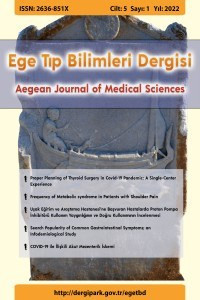Fonksiyonel Nörolojik Semptom Bozukluğunda Bilişsel Davranışçı Tedavinin Bilişsel Hatalar Üzerine Etkisi
Fonksiyonel nörolojik semptom bozukluğu, konversiyon bozukluğu, bilişsel davranışçı tedavi, biliş, ilaç tedavisi
The Effect of Cognitive Behavioral Therapy on Cognitive Errors in Functional Neurological Symptom Disorder
Functional neurological symptom disorder, conversion disorder, cognitive behavioral therapy, cognition, drug therapy,
___
- 1. Karadag AS, Kalenderoglu A, Orum MH. Optical coherence tomography findings in conversion disorder: are there any differences in the etiopathogenesis of subtypes? Arch Clin Psychiatry. 2018;45(6):154-60.
- 2. Perez DL, Barsky AJ, Daffner K, Silbersweig DA. Motor and somatosensory conversion disorder: a functional unawareness syndrome? J Neuropsychiatry Clin Neurosci. 2012;24(2):141-51.
- 3. Boeckle M, Liegl G, Jank R, Pieh C. Neural correlates of conversion disorder: overview and meta-analysis of neuroimaging studies on motor conversion disorder. BMC Psychiatry. 2016;16:195.
- 4. Hingray C, Biberon J, El-Hage W, De Toffol B. Psychogenic non-epileptic seizures (PNES). Rev Neurol (Paris). 2016;172(4-5):263-9.
- 5. Tsui P, Deptula A, Yuan DY. Conversion disorder, functional neurological symptom disorder, and chronic pain: comorbidity, assessment, and treatment. Curr Pain Headache Rep. 2017;21(6):29.
- 6. Leary PM. Conversion disorder. Handb Clin Neurol. 2013;112:883-7.
- 7. O'Neal MA, Baslet G. Treatment for patients with a functional neurological disorder (conversion disorder): an integrated approach. Am J Psychiatry. 2018;175(4):307-14.
- 8. Butler AC, Chapman JE, Forman EM, Beck AT. The empirical status of cognitive-behavioral therapy: a review of meta-analyses. Clin Psychol Rev. 2006;26(1):17-31.
- 9. Kozlowska K, Palmer DM, Brown KJ, Scher S, Chudleigh C, Davies F, Williams LM. Conversion disorder in children and adolescents: a disorder of cognitive control. J Neuropsychol. 2015;9(1):87-108.
- 10. American Psychiatric Association. (2013). Diagnostic And Statistical Manual Of Mental Disorders, Fifth Edition (DSM-5). Arlington, VA: APP.
- 11. Nijenhuis ERS, Spinhoven P, Van Dyck R, Van Der Hart O, Vanderlinden J. the development and psychometric characteristics of the somatoform dissociation questionnaire (SDQ-20). J Nerv Ment Dis. 1996;184(11):688-94.
- 12. Sar V, Kundakçι, T, Kιzιltan E, Bakim B, Bozkurt O. Differentiating dissociative disorders from other diagnostic groups through somatoform dissociation in Turkey. J Trauma Dissociation. 2000;1(4):67-80.
- 13. Özdel K, Taymur I, Guriz SO, Tulaci RG, Kuru E, Turkcapar MH. Measuring cognitive errors using the cognitive distortions scale (CDS): Psychometric properties in clinical and non-clinical samples. Plos ONE. 2014;9(8):E105956.
- 14. Endicott J, Spitzer RL, Psychiatric Rating Scales. In Comprehensive Textbook Of Psychiatry, 5th Ed.; Kaplan HI, Sadock BJ Eds.; Williams & Wilkins: Baltimore, Maryland: 1989; pp. 2391-09.
- 15. Waller E, Scheidt CE. Somatoform disorders as disorders of affect regulation: A study comparing the tas-20 with non-self-report measures of alexithymia. J Psychosom Res. 2004;57:239-47.
- 16. Voon V, Lang AE. Antidepressant treatment outcomes of psychogenic movement disorder. J Clin Psychiatry. 2005;66:1529-34.
- 17. Sharpe M, Walker J, Williams C, Stone J, Cavanagh J, Murray G, et al. Guided self-help for functional (psychogenic) symptoms: a randomized controlled efficacy trial. Neurology. 2011;77:564-72.
- 18. Lafrance WC Jr, Baird GL, Barry JJ, Blum AS, Webb AF, Keitner GI, et al. Multicenter pilot treatment trial for psychogenic nonepileptic seizures: a randomized clinical trial. JAMA Psychiatry. 2014;71:997-1005.
- 19. Örüm MH. The relationship between cognitive errors and psychiatric symptoms in obsessive-compulsive disorder. Med J Ankara Tr Res Hosp. 2020;53(1):29-35.
- 20. Orum MH. Investigation of the relationship between cannabis use, opioid use and cognitive errors. Medicine Science. 2020;9(2):362-9.
- 21. Örüm MH. Cognitive error characteristics of rumination and cleaning dimensions of obsessive-compulsive disorder. Anadolu Psikiyatri Derg. 2020;21(6):592-9.
- 22. Örüm MH, Kara MZ, Kuştepe A, Kalenderoğlu A. Bilişsel hatalar ve dikkat-eksikliği hiperaktivite bozukluğu belirtilerinin madde kullanım özellikleri ile ilişkisi. Bağımlılık Dergisi–Journal Of Dependence. 2019;20(2):47-60.
- 23. Rachman S. The evolution of behaviour therapy and cognitive behaviour therapy. Behav Res Ther. 2015;64:1-8.
- ISSN: 2636-851X
- Yayın Aralığı: Yılda 3 Sayı
- Başlangıç: 2018
- Yayıncı: Uşak Cerrahi Derneği
Arzu ŞENOL, Zülal AŞCI TORAMAN
Kolorektal Adenokarsinomu Taklit Eden Nonadenokarsinom Tümörlerin Retrospektif Analizi
ANKARA KEÇİÖREN EĞİTİM VE ARAŞTIRMA HASTANESİ KAWASAKİ HASTALIĞI DENEYİMİ
Mesut KOÇAK, Şeyma KAYALI, Aslı ÇELEBİ TAYFUR, Aysun ÇALTIK YILMAZ, Bahar BÜYÜKKARAGÖZ
